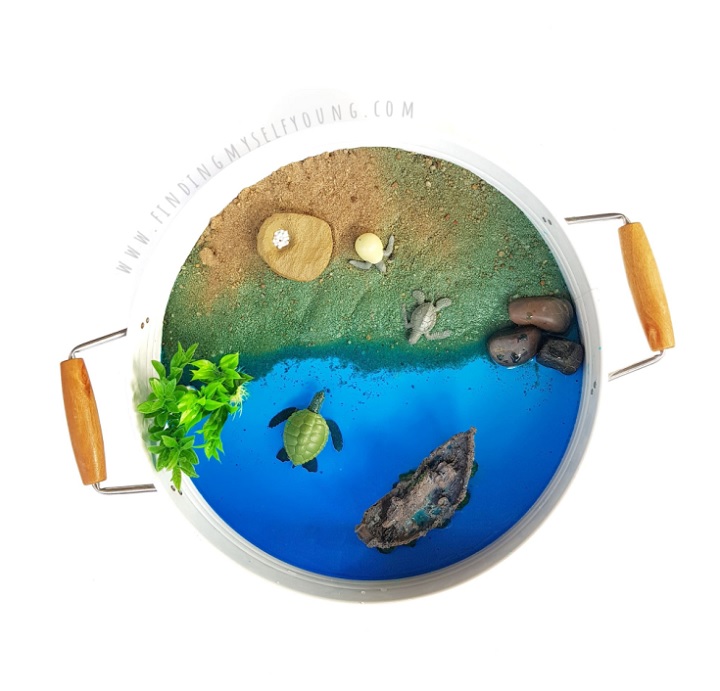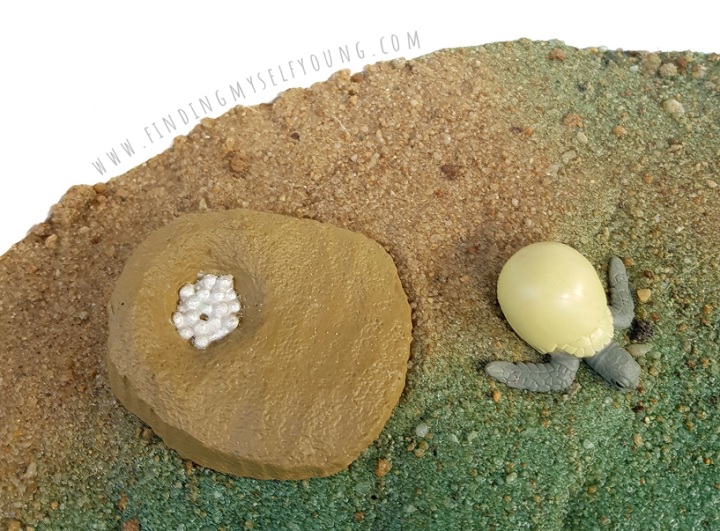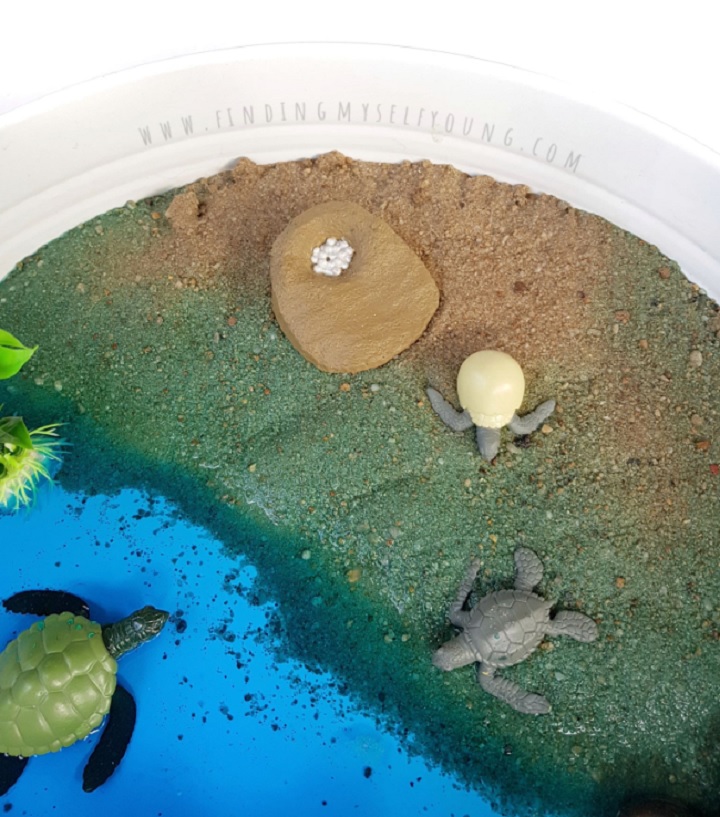This sea turtle small world is a great hands on way to teach turtle life cycles to young children and is also a fun sensory experience exploring the texture and feel of sand and water. It's a fun way to explore science either in the classroom, or at home.
Some children learn best by reading information, however my children definitely learn best hands on through play, so I introduced the life cycle of a turtle using a small world play tray with animal figurines. I find my children definitely learn and absorb so much information by being able to touch and manipulate figurines while playing. They're also big sensory seekers so anything with a sensory element is a big win, which is why we love small world play so much!
SEA TURTLE LIFE CYCLE FACTS
Turtles are one of the most fascinating reptiles as they live for approximately 50 years, there's even cases of some sea turtles living over 100 years. There are 7 different species of sea turtles, the Loggerhead, Green sea turtle, Leatherback, Hawksbill, Kemp's Ridley, Olive Ridley and Flatback. The life cycle of a sea turtle has 4 stages: Eggs > Hatchlings > Juveniles > Adults.
Female sea turtles will return to the beach they were born to lay their own eggs. They create a nest by digging a body pit with their flippers, where they will lay up to 200 eggs, they then cover it to camouflage it from predators. Approximately 6-8 weeks later the eggs will start hatching and the baby turtles, hatchlings, will emerge and climb out of the nest. The hatchlings will make their way from the nest to the ocean as a collective group at night time to avoid predators.
Once they've reached the ocean the hatchlings will swim out to sea and be taken by currents to different parts of the ocean where they spend years maturing into juveniles and then adult turtles. Once they've matured to mating age {usually 10-30 years depending on the species of sea turtle} they will mate and the female turtles will return to the beach they were born at to lay their own eggs, and the cycle will continue. Although turtles return to the same beach to lay eggs, they leave as soon as they've laid their eggs so the female turtles never actually meet their own babies, the hatchlings learn how to survive on their own.
This activity is intended to be done under strict adult supervision.
SEA TURTLE LIFE CYCLE INVITATION TO PLAY
- Tray
- Sand
- Water
- Food colouring {optional}
- Turtle life cycle figurines
- Aquarium plants
- River rocks
The sea turtle life cycle pack from Safari is the perfect set to use for a turtle small world as it represents every stage of the turtle life cycle from eggs through to adult. We got ours from The Messy Caterpillar {use code FMY15 to save 15%} or you an also find them online at Amazon. I used real sand and added water which I dyed with blue food colourig {you can leave the food colouring out if you don't have it or don't want to use it}. I kept this small world fairly simple just adding in a few aquarium plants, rocks and a ceramic boat, so that the focus remained on the turtles. You can decorate your small world with as much or as little additional decor as you like. I particularly love using aquarium pieces when we're using water, however be mindful of your child's age if you want to use ceramic pieces. You can find small world pieces at pet stores, dollar stores, department stores and in my Amazon store.
HOW TO CREATE A TURTLE LIFE CYCLE SMALL WORLD
1. Create a beach by filling 1/3 to 1/2 of the tray with sand.
2. Slowly pour in water until it comes half way up the height of the sand.
3. Add accessories {plants, rocks etc}
4. Position turtle figurines on the sand and in water.
I ended up using too much blue food colouring in our small world as a huge lot came out at once into the water {whoops} so it ended up slightly staining the sand where it absorbed. To avoid this happening use food colouring with a dripper dispensing top or use a pipette to add only 2-3 drops to the water. Good news though is that it didn't stain the girls hands even though it was a lot darker than I originally intended.
Both my girls played with this tray differently. My older girl went straight into sensory play scooping the sand up and making it all muddy. She had lots of fun squishing and dropping the sand around watching it splat into the water {although she did make a big mess!}. My toddler spent ages using the figurines for imaginary play.
I would definitely suggest doing this activity outside to make clean up easier. Because my daughter was mixing the sand up with the water so much it made a sloppy wet cement consistency and it went everywhere. Even though it looks quite gross in the image above, to me that represents a successful play tray as both girls got in and played with it until it was literally destroyed. Clean up was still easy though with a quick rinse under the hose.
TURTLE LIFE CYCLE RESOURCES
Sometimes small world play can spark a deeper interest in a topic and children may want to explore it in more depth via other materials and resources. There are many turtle life cycle books, puzzles and story discs available online. Posters and flashcards may also be great additions to a living things unit in a classroom setting.
MORE LIFE CYCLE SMALL WORLDS
To keep up to date with my latest posts and play activities you can sign up to my email list or follow me on Instagram, Pinterest & Facebook. I'd also love for you to join parents from all around the world in our Facebook community Finding Play Ideas.
Disclosure - This post contains some affiliate links for your convenience which means I may earn a small commission, at no cost to you, should you make a purchase. The Messy Caterpillar discount code {FMY15} is available to Australian readers and is valid on all items in stock, excluding mud kitchens.











